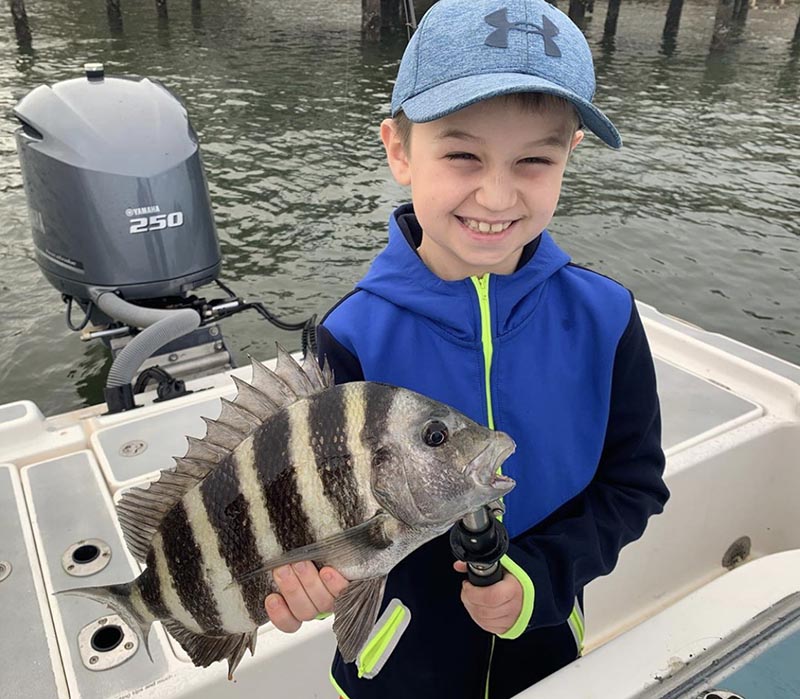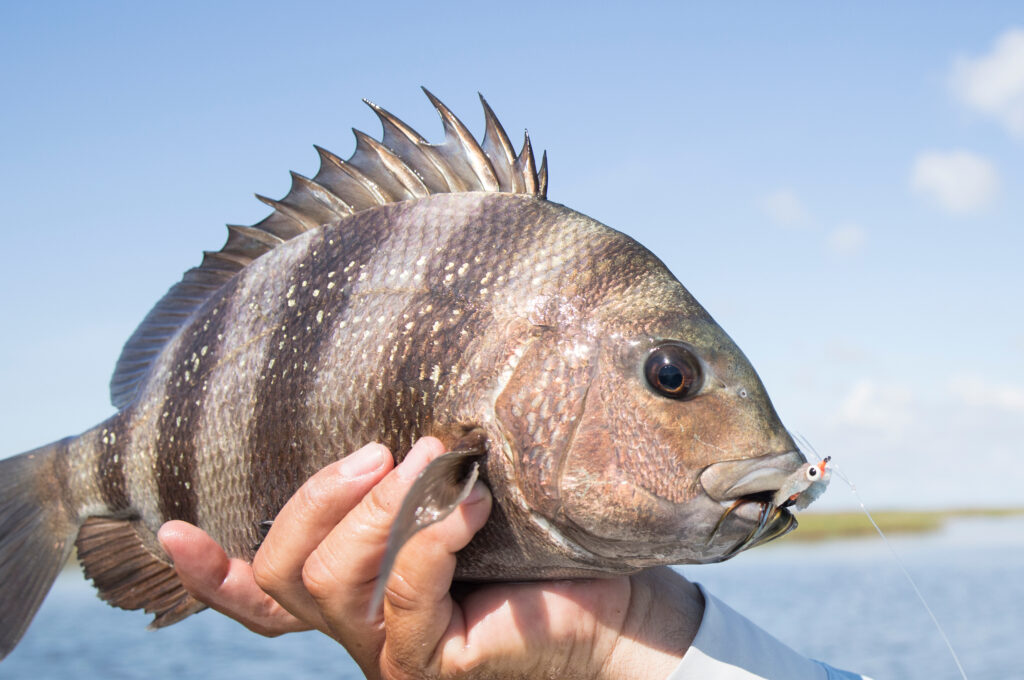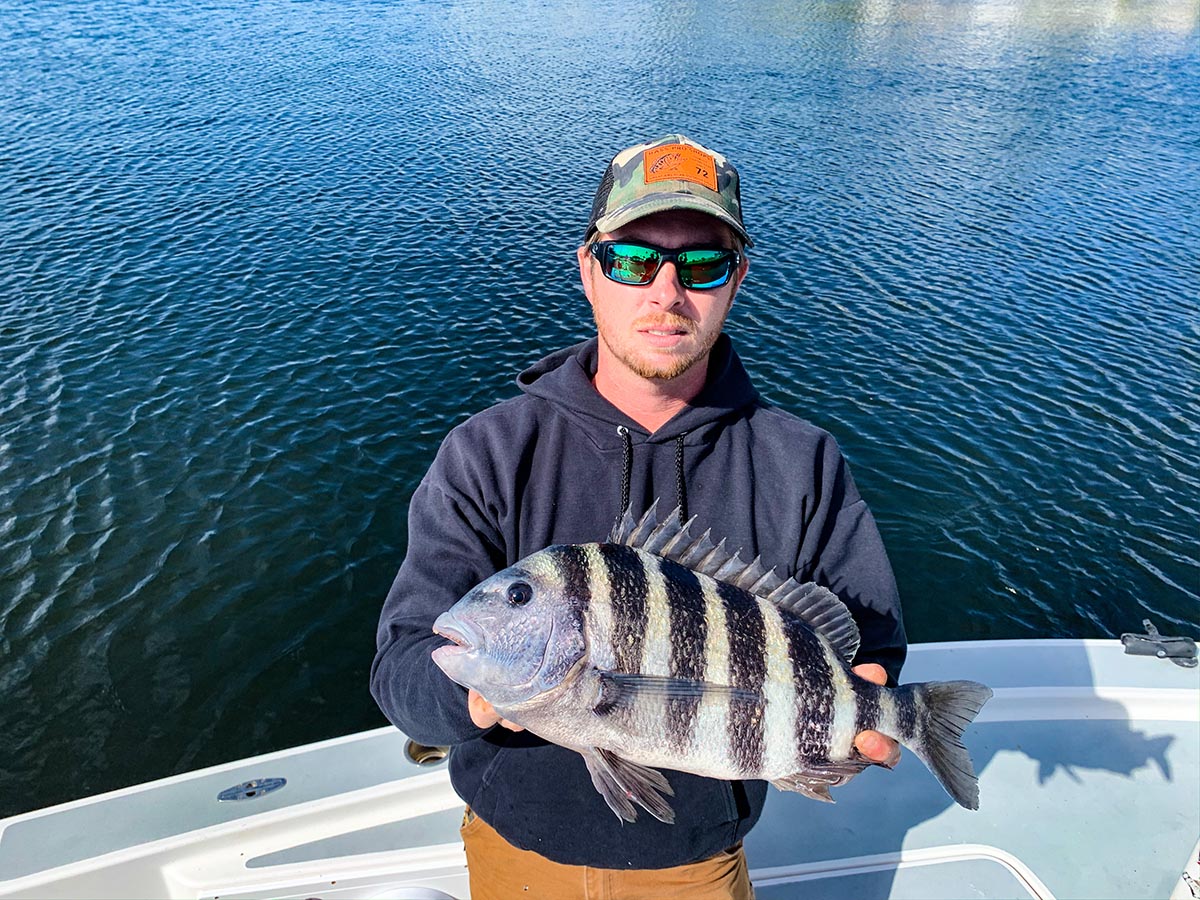Last Updated on October 29, 2025 by Writer
When winter rolls into the Gulf Coast, most inshore fishermen expect a slowdown. Baitfish thin out, water temperatures dip, and many warm-water favorites grow sluggish. Yet beneath the bridges and along the barnacle-coated pilings of Anna Maria Island, another story unfolds. This is the season when sheepshead, a stout, striped porgy with a mouth full of human-like teeth, takes center stage. From December through early spring, they dominate the inshore bite and provide steady action when nearly every other species has pulled back.
Understanding the Sheepshead
The sheepshead (Archosargus probatocephalus) is one of Florida’s most recognizable saltwater fish. Its black vertical bars and silver-gray body give it a “zebra” appearance, while its square jaw houses a full set of incisors and molars designed to crush shellfish. These teeth are their evolutionary tool for feeding on crustaceans, barnacles, oysters, and small crabs, foods that remain abundant even through the coldest months.
Adult sheepshead typically measure between 12 and 18 inches, though larger specimens exceeding 20 inches and weighing up to 10 pounds are common in the Gulf. They inhabit coastal waters from the Carolinas through Texas but are especially abundant in Florida’s bays, estuaries, and nearshore reefs. Around Anna Maria Island, they thrive wherever there is structure, making them a prime wintertime quarry for both casual and dedicated fishermen.
Why Winter Belongs to Sheepshead
Winter does not simply bring sheepshead to life; it concentrates them. As water temperatures fall, these fish gather in large numbers around hard structure to feed and prepare for spawning. The cold, clear water of December and January signals the start of pre-spawn activity. By February and March, mature fish stage on channel edges, reef systems, and bridge pilings to spawn in the nearshore Gulf.
While many species slow down in chilly conditions, sheepshead remain active. Their diet of shellfish ensures they always have something to eat, and the seasonal congregation makes them easier to locate. Local guides often refer to this period as the “convict run,” when fish stack so densely that a skilled fisherman can fill a limit within an hour if the tide and structure line up.

Identifying a True Sheepshead Hotspot
The best sheepshead fishing near Anna Maria Island begins where barnacles grow thickest. Prime areas include:
- Bridge pilings and seawalls along the Manatee River, Cortez Bridge, and Anna Maria’s northern passes.
- Older residential docks where oyster and barnacle growth creates natural feeding stations.
- Jetties and rock groins at the mouth of Tampa Bay, especially where current scours exposed rock.
- Nearshore artificial reefs within 2 to 10 miles of the beaches, often holding spawning groups through late winter.
Rather than fixating on a single dock or piling, think in categories of structure. A fisherman who understands what the fish need, hard surface, moderate current, and access to barnacles, will find them repeatedly across the region.
The Winter Technique
Targeting sheepshead successfully requires patience and precision. These fish are notorious bait thieves with an exceptionally light bite. A typical setup includes:
- Rod and Reel: Medium-light spinning gear with a sensitive tip to detect subtle takes.
- Line: 10–15 lb braided main line with a 20–25 lb fluorocarbon leader.
- Terminal Tackle: Small #1 or 1/0 J-hooks or short-shank circle hooks paired with a split-shot or light knocker rig.
- Baits: Live fiddler crabs, small pieces of shrimp, oyster meat, or barnacle fragments.
Lower the bait tight against the piling or rock face and let it rest near the bottom. The bite rarely feels like a hit. More often, the weight simply feels lighter or stops vibrating with the current. When that happens, lift gently. If the fish is there, the rod will bend.
Timing the tide is another key to winter success. Sheepshead feed best on moving water, especially when current flow exposes barnacles or shifts crabs off structure. After a cold front, the clear, high-pressure conditions that silence other species often spark an excellent sheepshead bite.
Seasonal Calendar and Behavior
- December: The first strong fronts cool the water, pushing fish toward deeper docks and bridges.
- January: Numbers swell as adults gather along Tampa Bay’s edges and local reefs.
- February and March: Peak spawning and the height of the bite. Large groups occupy the Skyway channel edges, Egmont Key rockpiles, and artificial reefs just off AMI.
- April: As temperatures rise, fish disperse again into bays and grass flats, and the frenzy fades until the next winter.
These months also coincide with Florida’s stricter vessel limits, reflecting how predictable and vulnerable the aggregations become. Responsible harvest ensures the fishery remains healthy for years to come.
Regulations Worth Knowing
Florida keeps sheepshead open year-round, but size and bag limits matter. Each fisherman may keep up to 8 fish per day, with a minimum size of 12 inches. During March and April, a 50-fish vessel limit applies to prevent over-harvest of spawning groups. Legal gear includes hook and line, cast nets, and spears, but snagging or using multiple hooks with natural bait is prohibited. Always verify regulations through the Florida Fish and Wildlife Conservation Commission before heading out.

Cleaning and Cooking Rewards
Sheepshead are heavily armored, with thick scales and dorsal spines that challenge any fillet knife. Once cleaned, their meat is firm, white, and mild, prized for versatility in the kitchen. Fried fillets remain a Gulf Coast staple, but baking or grilling also brings out the delicate flavor. The quality of their meat explains why so many winter fishermen devote entire days to catching them despite the effort required to clean a full limit.
Comparing Seasonal Dominance
Sheepshead exist along Anna Maria Island all year, but winter is when they own the inshore scene. In warmer months, their bite competes with snook, redfish, and trout, each commanding more attention from visiting fishermen. When those species retreat or slow down in cold water, sheepshead step forward as the dependable target. Their steady activity and grouping behavior transform winter from an off-season into one of the most productive times to fish the area.
Fishing with Local Expertise
Every piling, reef, and tide behaves differently across the island’s network of bays and passes. Local captains who track these patterns daily can shorten the learning curve dramatically. They understand which wind directions open certain reef bites, when the tide turns best under a specific bridge, and how subtle temperature changes affect the pre-spawn groups. A guided winter trip puts you right in the middle of that action, with access to prime spots and the local insight that makes each tide productive.
Winter on Anna Maria Island rewards those who appreciate its quieter side. When the air turns crisp and the docks fall silent, sheepshead gather in vast schools that bring life to every piece of structure in the bay. This is their season, and it is the perfect time to experience it firsthand with Captain Nate, who knows these waters and the habits of winter sheepshead better than anyone. Book a trip with us and discover why winter sheepshead fishing is one of the most rewarding inshore experiences Florida has to offer.




